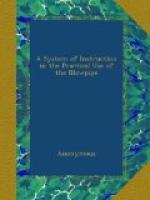Sesquioxide of Antimony (Sb^{2}O^{3}).—In the pure state this oxide is a white powder, is fusible at a dull red heat to a yellow liquid, which, after cooling, is greyish-white and crystalline. If it is heated excluded from the air, it can be volatilized completely; it sublimes in bright crystals having the form of needles. It occurs sometimes in nature as white and very bright crystals. It takes fire when heated in the open air, and burns with a white vapor to antimonious acid. It fuses with the ter-sulphide of antimony to a red bead. It is distinguished from the other oxides of antimony by the readiness with which it is reduced to the metallic state upon charcoal, and by its easy fusibility and volatility.
The sesquioxide is the base of some salts—for instance, the tartar emetic. It is not soluble in nitric acid, but is soluble in hydrochloric acid. This solution becomes milky by the addition of water. A part of the salts of the sesquioxide of antimony are decomposed by ignition. The haloid salts are easily volatilized, without decomposition. Its soluble neutral salts change blue litmus paper to red, and are converted, by admixture of water, into insoluble basic and soluble acid salts.
Antimonious acid (antimoniate of sesquioxide of antimony, Sb^{2}O^{3} + Sb^{2}O^{5}) is of a white color, but, when heated, of a light yellow color, but changes to white again when cold. It is infusible and unaltered by heat. It forms a white hydrate, and both are insoluble in water and nitric acid. It is partly soluble in hydrochloric acid, with the application of heat. The addition of water causes a precipitate in this solution.
Antimonic Acid (Sb^{2}O^{5}).—In the pure state this acid is a light yellow-colored powder. Its hydrate is white, and is insoluble in water and nitric acid. It is sparingly soluble in hot concentrated hydrochloric acid. It forms salts with every base, some of which are insoluble, and others sparingly so. Notwithstanding that antimonic acid is insoluble in water, it expels the carbonic acid from the solutions of the carbonates of the alkalies. Antimonic acid and its hydrate changes moistened blue litmus paper to red.
Behavior of Antimony and its Oxides before the Blowpipe.
Metallic Antimony fuses easily upon charcoal. When heated to glowing, and then removed from the flame, it continues to glow for awhile, and produces a thick white smoke. The vapor crystallizes gradually, and coats the assay with small crystals which iridesce like mother of pearl (sesquioxide of antimony). It is not volatile at the temperature of melted glass. Ignited in an open glass tube, it burns slowly with a white vapor, which condenses upon the cool part of the tube, and exhibits some indications of crystallization. This vapor consists of the sesquioxide, and can be driven by heat from one place to another, without leaving a residue. If the metallic antimony contains sulphide of antimony, there is a corresponding portion of antimonious acid produced, which remains as a white sublimate after the sesquioxide is removed.




